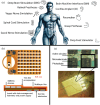Area Selective Atomic Layer Deposition for the Use on Active Implants: An Overview of Available Process Technology
- PMID: 39723707
- PMCID: PMC11804845
- DOI: 10.1002/adhm.202403149
Area Selective Atomic Layer Deposition for the Use on Active Implants: An Overview of Available Process Technology
Abstract
Area-selective atomic layer deposition (ASD) is a bottom-up process that is of particular importance in the semiconductor industry, as it prevents edge defects and avoids cost-intensive lithography steps. This approach not only offers immense potential for the manufacture of active implants but can also be used to improve them. This review paper presents various processes that can be used for this purpose. It also identifies aspects that shall be considered when implementing such a process for medical applications. For example, the inherent selectivity can be used to produce new biosensors, the passivated ASD can be used to encapsulate polymer-based implants, and the activated ASD can be used to improve electrode performance. Finally, the aspects that shall be considered in a coating for active implants are highlighted. ASD therefore offers great potential for use on active implants.
Keywords: active implantable medical devices; area selective atomic layer deposition; coating technologies; encapsulation strategies; surface reactions.
© 2024 The Author(s). Advanced Healthcare Materials published by Wiley‐VCH GmbH.
Conflict of interest statement
The authors declare no conflict of interest.
Figures





Similar articles
-
Orthopedic coating materials: considerations and applications.Expert Rev Med Devices. 2009 Jul;6(4):423-30. doi: 10.1586/erd.09.17. Expert Rev Med Devices. 2009. PMID: 19572797 Review.
-
Insulator semiconductor structures coated with biodegradable latexes as encapsulation matrix for urease.Biosens Bioelectron. 2005 May 15;20(11):2318-23. doi: 10.1016/j.bios.2004.10.010. Biosens Bioelectron. 2005. PMID: 15797333
-
Biomedical applications of electrostatic layer-by-layer nano-assembly of polymers, enzymes, and nanoparticles.Cell Biochem Biophys. 2003;39(1):23-43. doi: 10.1385/CBB:39:1:23. Cell Biochem Biophys. 2003. PMID: 12835527 Review.
-
Long-term bilayer encapsulation performance of atomic layer deposited Al₂O₃ and Parylene C for biomedical implantable devices.IEEE Trans Biomed Eng. 2013 Oct;60(10):2943-51. doi: 10.1109/TBME.2013.2266542. Epub 2013 Jun 6. IEEE Trans Biomed Eng. 2013. PMID: 23751949
-
Atomic layer deposition of nano-TiO2 thin films with enhanced biocompatibility and antimicrobial activity for orthopedic implants.Int J Nanomedicine. 2017 Dec 8;12:8711-8723. doi: 10.2147/IJN.S148065. eCollection 2017. Int J Nanomedicine. 2017. PMID: 29263665 Free PMC article.
References
-
- House W. F., Urban J., Ann. Otol., Rhinol., Laryngol. 1973, 82, 504. - PubMed
-
- Lorach H., Galvez A., Spagnolo V., Martel F., Karakas S., Intering N., Vat M., Faivre O., Harte C., Komi S., Ravier J., Collin T., Coquoz L., Sakr I., Baaklini E., Hernandez‐Charpak S. D., Dumont G., Buschman R., Buse N., Denison T., van Nes I., Asboth L., Watrin A., Struber L., Sauter‐Starace F., Langar L., Auboiroux V., Carda S., Chabardes S., Aksenova T., et al., Nature 2023, 618, 126. - PMC - PubMed
-
- a) Hochberg L. R., Serruya M. D., Friehs G. M., Mukand J. A., Saleh M., Caplan A. H., Branner A., Chen D., Penn R. D., Donoghue J. P., Nature 2006, 442, 164; - PubMed
- b) Collinger J. L., Wodlinger B., Downey J. E., Wang W., Tyler‐Kabara E. C., Weber D. J., McMorland A. J. C., Velliste M., Boninger M. L., Schwartz A. B., Lancet 2013, 381, 557. - PMC - PubMed
Publication types
MeSH terms
Substances
LinkOut - more resources
Full Text Sources

